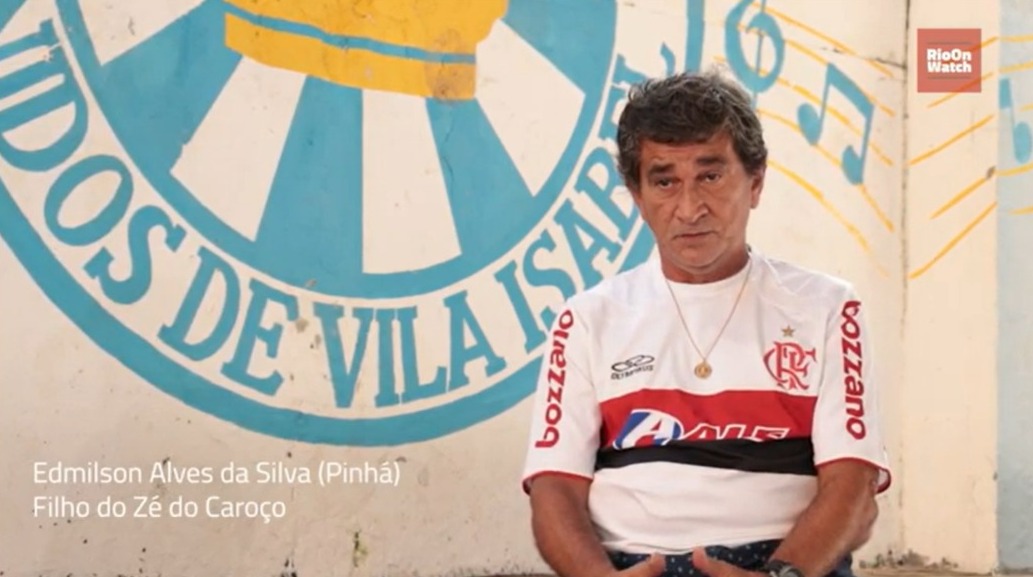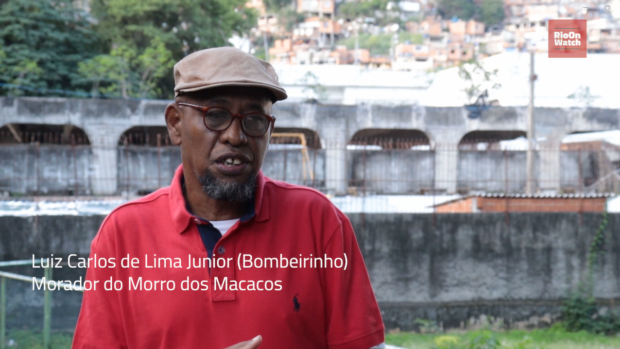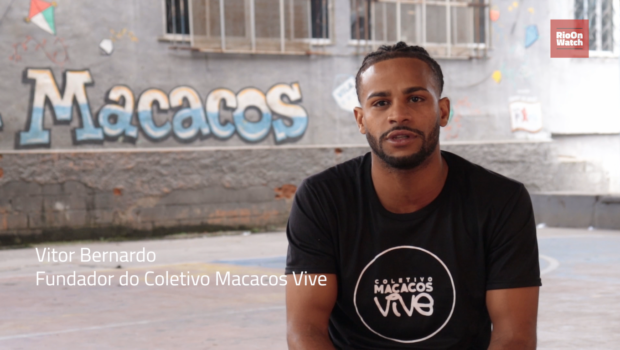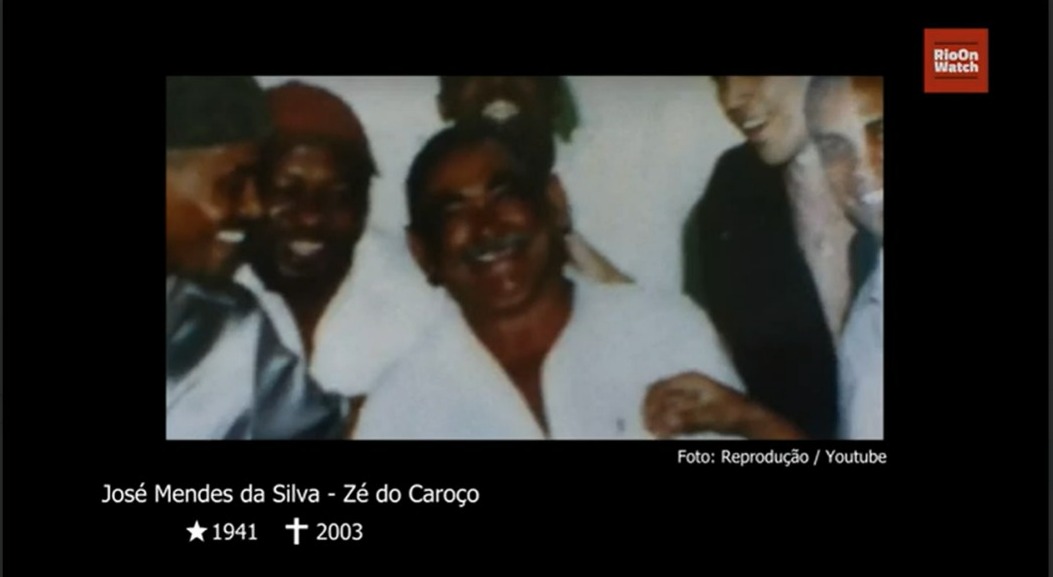This video report, with English subtitles, relives passages of the life of favela communicator José Mendes da Silva, forever known as Zé do Caroço, whose name resonates in one of the most famous Brazilian sambas, written by Leci Brandão. The video shares the perspectives of four interviewees: Edmilson Alves da Silva, Zé do Caroço’s son; Luiz Carlos de Lima Junior, affectionately known in the favela as Bombeirinho; singer Xande de Pilares; and Vitor Bernardo, from the Macacos Vive media collective. Among them, there is a consensus that José Mendes da Silva “planted a seed of a tree that would only provide shade many years later, but he was sure that, in the future, someone would enjoy it.”
“A new (popular!) leader is being born
in the Pau da Bandeira favela.”Leci Brandão
So proclaimed singer-songwriter Leci Brandão. The passage is from a samba released in 1985 about grassroots communicator José Mendes da Silva, forever known as Zé do Caroço, after whom the samba is named. The video report aims to recover memories not only from those who knew the Pernambuco native and Rio de Janeiro migrant in life but also from those familiar with his legacy. Set in the Morro dos Macacos favela complex, where the Pau da Bandeira community is located in the Vila Isabel neighborhood, in Rio de Janeiro’s North Zone, 20 years after Zé do Caroço’s passing, the production captures, in its images, the local sense of belonging and life experiences in the territory where he lived and worked for most of his life.

Wearing a Flamengo soccer jersey and an Our Lady of Aparecida pendant around his neck, Edmilson Alves da Silva, Zé do Caroço’s son, shares memories of his father. At 58, he exudes sensitivity, admiration and pride in being the child of one of the pioneers of favela communication in Rio de Janeiro, not to mention being the central figure in one of the most memorable sambas in the history of Brazilian music.
“He set up a loudspeaker [way up in the favela] along with a table. Letters would come in, he’d announce the names of people over the community radio and they’d come to pick them up at his little bar. It was genuinely a social information service.” — Edmilson Alves da Silva
José Mendes da Silva’s creative organizing in his territory is eternalized in Leci Brandão’s song:
“Through a loudspeaker service
In the Pau da Bandeira Favela
Zé do Caroço is giving the heads up
Tomorrow he’s gonna stir things up
Warning the entire favela!”Leci Brandão

Another interviewee was Luiz Carlos de Lima Junior, better known as Bombeirinho, 59, a resident of Morro dos Macacos. He analyzes the potential of Zé do Caroço’s legacy. Lima Junior emphasizes that da Silva was highly popular and respected in Vila Isabel, as well as being one of the pioneers of favela media, even during the military dictatorship.
“He possessed amazing collective initiative. He lived at a time when things were censored but he spoke up anyway, breaking away from all that censorship stuff… There used to be this soap opera moment [when everyone stopped to watch the soap on TV]. And that’s when Zé do Caroço would shine [on the loudspeaker]: raising awareness about prices at the supermarket, at the street market.” — Luiz Carlos de Lima Junior, Bombeirinho
This engaged profile of da Silva, as narrated by Bombeirinho, is also imprinted in the Brazilian social imaginary through Leci Brandão’s hit samba:
“And Zé do Caroço works,
And Zé do Caroço struggles,
And hollers about food prices.
And when Brazilian TV
Numbs everyone with its soap opera
That’s when Zé blows the whistle
Delivering a heartfelt speech
All for the good of the favela!”Leci Brandão
The gentleman with a cap and red polo shirt shares an analogy about planting a tree when remembering Zé do Caroço: “He planted the seed of a tree that would only provide shade many years later but he was sure that, in the future, someone would enjoy it.” For Bombeirinho, it is evident that da Silva’s work remains alive, especially through community initiatives, such as Macacos Vive, an independent media collective.

Vitor Bernardo, 30, founder of the Macacos Vive media collective, never had any contact with Zé do Caroço. But decades later, the collective also emerges as independent grassroots media in the same area, sharing the same goal as da Silva: to inform the favela. As a lawyer and native of Morro dos Macacos, Bernardo believes that community-led media help disseminate information on the rights of residents.
“[Zé do Caroço] was a natural leader… He could accomplish things that were uncommon in many favelas. A pioneer of community radio… We’re talking decades ago, when cell phones weren’t around. And, in his way, he managed to disseminate information within the favela that the community didn’t have access to. He didn’t have Instagram, he didn’t have Facebook: he had a loudspeaker on top of the favela, shouting to everyone what the community needed to hear… Zé do Caroço was ahead of his time.” — Vitor Bernardo
Also featured in the the video report is Xande de Pilares, 53, a former member of the Grupo Revelação samba group. The singer, born and raised in Morro da Chacrinha, in Complexo do Turano, Tijuca, shares the story of the night he met da Silva. He also recalls singing Zé do Caroço in samba circles before the song was even recorded by Leci Brandão.
“We re-recorded it with Leci’s participation and in the presence of Zé do Caroço, at a nightclub called Olimpo, in Vila da Penha… Zé do Caroço was highly regarded, both by residents and by the composers that hung out at his small bar.” — Xande de Pilares
Watch the Video Report with English Subtitles Here.
About the author and producer: Thayná de Souza, 27, was born and raised in Morro do Providência, in Rio de Janeiro’s Port Area. Currently a Journalism student at the Federal University of Rio de Janeiro (UFRJ), she has a passion for discussing music, culture, and the right to the city, seamlessly integrating her lived experiences with her studies in Communication. Presently, she works as a journalist for Voz das Comunidades and is an educator at the Mulheres Independentes da Providência (MIP – Casa Amarela) collective.
About the author: Amanda Botelho, 26, is a journalist with a postgraduate degree in Social Media. Born and raised in Morro da Formiga in Tijuca in Rio’s North Zone, she started out in community media as a reporter with Voz das Comunidades. She currently works as a video reporter for Estadão.
About the editor: William Santos, 36, holds a degree in Cinema from the Fluminense Federal University (UFF) and has been working as a cameraman since the age of 14. Born and raised in Irajá, in the North Zone of Rio de Janeiro, he has been involved in the Fala Serrinha project and NGO Voz das Comunidades. He currently undertakes independent projects in image capture and editing.
About the videomaker: Brunno Paschoal, 30, is a videomaker and audiovisual producer. A resident of Complexo do Alemão, in the North Zone of Rio, he is the entrepreneur behind Storm Videos Criativos, a company engaged in audiovisual production both within and outside the favela. Additionally, he serves as videomaker for Voz das Comunidades and as the post-production editor for the TV program “Bom dia Favela” on the free-to-air television network Band.

